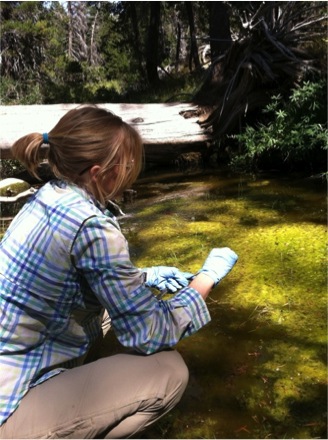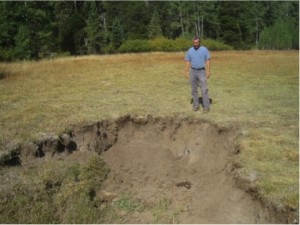CSERC fieldwork and monitoring efforts sampled water quality, measured meadow impacts, and located sites with resource damage.
Why does on-the-ground fieldwork matter?
Because we serve on the front lines of issues that affect the environment of the Northern Yosemite region, CSERC staff uses field monitoring as a pivotal tool. Our credibility at key meetings is always high when we can describe what actually is occurring or share pictures or otherwise show the monitoring that we’ve completed.
Over the long 2014 field season, Julia, Megan, Lindsey, and Michelle monitored 51 different meadows and associated riparian areas in the Stanislaus Forest. They took photos of livestock impacts, measured forage utilization use, and frequently repaired fences or volunteered to set up fences when the Forest Service lacked adequate manpower to do the work. Lindsey (at right) led CSERC’s water quality sampling of forest streams, adding data from this field season to previous years of water testing. The resulting analysis by an independent laboratory revealed where pathogenic bacteria posed risk to forest visitors who contact water or, even worse, actually drink from polluted streams.
John led the Center’s monitoring of the effects of projects within the Rim Fire and the initial recovery that came this spring and summer from re-sprouting trees, bushes, wildflowers, and groundcovers. He helped lead three separate Rim Fire field tours in partnership with the U.S. Forest Service. John also led CSERC’s monitoring of local area development projects in both Calaveras and Tuolumne counties.
 When CSERC staff attends key meetings in Sacramento at the State Water Board or with Regional USFS officials, our ability to point to our monitoring results provides compelling evidence. When we discuss a forest project with local USFS staff or complain to the timber industry about what we’ve seen on local private timberlands, our field expertise provides critical value.
When CSERC staff attends key meetings in Sacramento at the State Water Board or with Regional USFS officials, our ability to point to our monitoring results provides compelling evidence. When we discuss a forest project with local USFS staff or complain to the timber industry about what we’ve seen on local private timberlands, our field expertise provides critical value.
We encourage all of our members to share with us whenever you see resource threats, damage, or issues of significant concern.

